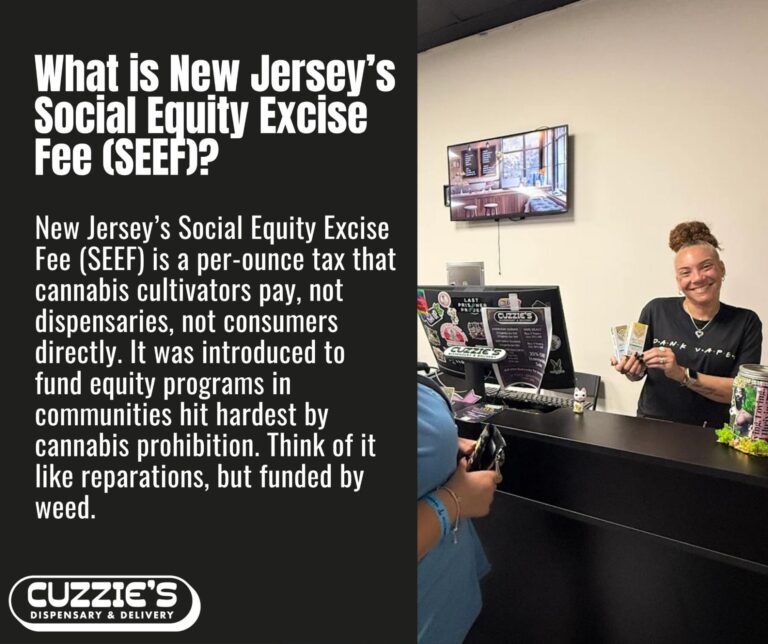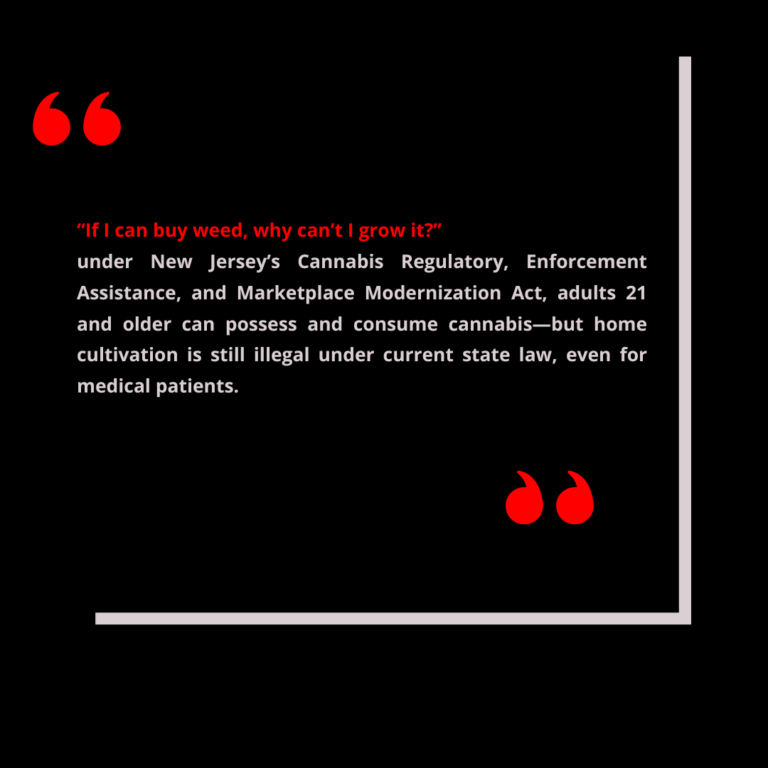New Jersey’s social equity tax (SEEF) was meant to help harmed communities, but $6M sits unspent, prices are rising, and small businesses are struggling. Learn how the tax works, who really pays, and how to fight for fairer weed policies in the Garden State.
The Real Cost of Equity: What’s Up With NJ’s Weed Tax?
Let’s be real for a second, New Jersey’s cannabis taxes are confusing as hell. If you’ve ever looked at your receipt and thought, “Wait, what’s this extra charge?” or if you’re a cultivator trying to stay compliant, you’ve probably bumped into the Social Equity Excise Fee (SEEF).
It sounds good on paper: a tax to help communities hit hardest by the War on Drugs. But ask around and you’ll hear the same story, no one really knows where the money’s going, and meanwhile prices keep climbing.
The Foundation: What is New Jersey’s Social Equity Excise Fee (SEEF)?


Defining the SEEF: A Tax with a Purpose
New Jersey’s Social Equity Excise Fee (SEEF) is a per-ounce tax that cannabis cultivators pay, not dispensaries, not consumers directly. It was introduced to fund equity programs in communities hit hardest by cannabis prohibition. Think of it like reparations, but funded by weed.
Sounds progressive, right?
The fee’s structure is tied to market price per ounce. For example:
- If the average retail price is $350+, cultivators pay $1.10/oz.
- When prices drop below $250, it jumps to $1.50/oz, and could rise to $2.50/oz in 2025 if the law evolves.
The idea: as weed gets cheaper, SEEF takes more per ounce to ensure funding stays steady.
But here’s the twist, that money’s not being spent. More on that in a sec.
Helpful Resoure -> New Jersey Weed Taxes
Who Pays What: Rates and Tiers for Cultivators
Here’s the quick math: cultivators (the growers) pay the SEEF based on the weight they sell, not the price they charge. So if you grow 10 pounds and sell wholesale, you owe the state based on total ounces moved.
It’s not per gram. It’s not a percentage of profit. It’s weight-based, and it adds up fast.
That’s why microbusinesses and social equity licensees say they’re getting hit the hardest. You’re just starting out, trying to compete, and before you even sell a joint, you owe the state hundreds to thousands in taxes.
SEEF vs. Other Cannabis Taxes: A Clear Distinction
To keep it 100:
- SEEF is separate from the 6.625% state sales tax and the up to 2% local tax that municipalities can charge.
- It doesn’t show up on your receipt at the dispensary, but it still affects what you pay, because cultivators pass the cost up the chain.
So when prices feel high, part of that could be SEEF working behind the scenes.
For many folks, it just feels like another weed tax, but with way less transparency than it should have.
The Promise vs. The Reality: Allocation, Impact & Unspent Funds
Investing in Justice: How SEEF Funds Should Be Used
The vision was bold: use SEEF revenue to heal communities devastated by the War on Drugs. That means reinvesting in:
- Legal aid for folks with cannabis convictions
- Workforce development and business grants in impact zones
- Youth programs and restorative justice efforts
The Cannabis Regulatory Commission (CRC) made recommendations on where those dollars should go, but here’s the kicker: they don’t control the money.
That’s up to the state legislature, and they’ve been dragging their feet hard.
The $6 Million Question: Why Funds Are Sitting Unspent
As of mid-2025, there’s over $6 million in unspent SEEF revenue just sitting. No programs launched. No grants issued. No impact.
Why? Because while the CRC made suggestions, the legislature never acted.
So we’ve got cultivators paying thousands in SEEF… consumers feeling the squeeze at checkout… and not a single community seeing the benefits.
This isn’t just a glitch, it’s a systemic stall. And it’s fueling deep distrust in how the system’s run.
Consumer Impact: Is SEEF Driving Up Your Prices?
Now technically, SEEF doesn’t appear on your receipt. But you better believe it’s baked into the price.
Here’s how:
- Cultivators pay SEEF → raise wholesale prices
- Dispensaries pass that to customers
- You end up paying more — especially when prices are already high
For some consumers, this means heading back to legacy markets, Telegram plugs, or out-of-state trips. If SEEF’s goal was to build trust and access, the current setup might be doing the opposite.
The People’s Voice: Unique Perspectives & Market Frustrations
The “Handicap” for Social Equity Licensees: Fees, Delays, and Barriers
For the folks SEEF was meant to uplift, especially Black and brown entrepreneurs in impact zones, this tax feels like a punchline.
You’re trying to build a dispensary or cultivation biz. But before your first harvest, you’re hit with:
- $1.50 per ounce in SEEF
- Thousands in licensing fees
- Long wait times and red tape
Many call it “paying to fail.” Instead of opening doors, the system’s putting locks on them. That ain’t equity, it’s bureaucracy in disguise.
Comparing NJ to Other Legal States: Are We Doing It Right?
Users online aren’t shy, they’re saying New Jersey’s got one of the worst setups out there.
Compared to states like:
- Oregon, where taxes are lower and homegrow is legal
- California, where social equity programs (while flawed) at least fund tangible services
- Or New York, where community reinvestment is more transparent
…Jersey feels behind. Expensive, restrictive, and lacking accountability.
Some even ask, “Should I move my operation to New York?” That’s how bad the cost-to-opportunity ratio looks to certain licensees.
The Shadow Market’s Allure: Legal vs. Legacy Price Wars
Here’s the truth no regulator wants to admit: the legacy market is thriving, and SEEF plays a role in that.
When taxed weed costs $60-$70 an eighth, but your neighborhood plug sells top-shelf for $40 with no tax? Consumers make choices.
Many buyers, especially those without deep pockets, opt out of the legal system, not because they don’t support equity, but because they literally can’t afford it.
Ironically, the tax meant to fund social programs might be fueling the same underground economy it was meant to replace.
Apathy, Distrust, and the “Cash Grab” Sentiment
Let’s be real: a lot of folks think SEEF is just another Jersey tax hustle.
You hear things like:
- “Just another cash grab.”
- “A tax to make the rich richer.”
- “Nobody even knows where the money goes.”
And with millions sitting unspent, can you blame them?
Public CRC hearings feel performative, like no one’s really listening. Business owners speak, but changes rarely follow. That disconnect breeds apathy, and a sense that equity is just a talking point, not a mission.
Navigating Compliance & Advocating for Change
Compliance for Cultivators: Reporting the SEEF
If you’re a licensed grower in Jersey, paying SEEF isn’t optional. You gotta file Form SF-100 and pay based on your weight output — usually in ounces.
Quick breakdown:
- It’s a volume-based excise fee
- Reported quarterly through the NJ tax portal
- You don’t pay by gram or retail price, it’s per ounce grown
But here’s the rub: most micro-cultivators don’t even turn a profit early on, and SEEF digs into margins before you’ve built customer trust.
Exemptions and Reduced Rates: A Lifeline for Microbusinesses?
There’s talk about reduced rates or exemptions for microlicense holders, but so far? Crickets.
Social equity businesses, the ones supposed to be protected, are often the least able to absorb these costs. Meanwhile, MSOs eat the fee and keep it movin’.
If Jersey’s serious about equity, it needs to offer actual relief, not just slogans and stacked bills.
Making Your Voice Heard: Engaging with the NJ-CRC
You got something to say? Show up. Speak up.
The Cannabis Regulatory Commission holds public hearings, and yes, they’re open to comment. You can:
- Submit written feedback
- Join virtual Zoom hearings
- Advocate directly for reform
Will they listen? That’s the million-dollar question. But your silence guarantees nothing changes.
The Future of Homegrow: A Demand for Personal Freedom


Everywhere you turn, people are asking: “If I can buy weed, why can’t I grow it?”
The SEEF is part of the broader frustration, it’s a tax on a system that doesn’t allow personal cultivation. For many, homegrow is the most affordable path to wellness or entrepreneurship.
Right now, it’s illegal. But pressure’s mounting. Advocacy groups and lawmakers are pushing for a homegrow bill, and public support is rising.
Industry Advocacy: Can Dispensaries Influence SEEF Rates?
They sure can. Dispensaries, especially large operators, have lobbyists, legal teams, and political weight.
But what about the little guys? That’s where collective action matters. Social equity applicants, microbusinesses, and consumers have power if they organize.
The fight over SEEF isn’t just about taxes, it’s about who shapes the future of weed in New Jersey.
Final Take: Social Equity or Same Old Tax Game?
Let’s keep it 100, New Jersey’s cannabis social equity tax started with good intentions. Fund the communities hit hardest by the war on drugs. Level the playing field for new operators. Build something fair.
But the rollout? Messy. Unspent funds. Rising costs. And a whole lot of people, from cultivators to consumers, wondering where the equity is.
Here’s what you need to remember:
- The SEEF is a per-ounce tax on cultivators, not consumers, but you’ll still feel it in retail prices.
- Millions in tax money meant for social programs remain untouched, trapped in bureaucracy.
- Social equity licensees say the fee hurts more than it helps.
- Consumers are frustrated. Businesses feel stuck. And legacy sellers? Thriving.
If you’re reading this, you’re already doing the work, staying informed, asking questions, and caring enough to challenge the system.
So What Can You Do?
- Support dispensaries that actually care about affordability and access.
- Push for homegrow. Push for transparency. Push for change.
- And if you’re in the game, as a cultivator, applicant, or advocate, get loud at CRC hearings.
